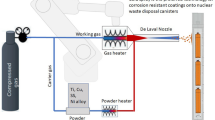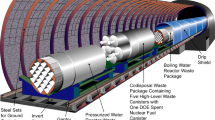Abstract
Radioactive contamination induced by nuclear leakage accidents, nuclear and radiation terrorism and other radioactive pollution events needs to be controlled and removed urgently, otherwise it will cause a wider range of pollution diffusion and radioactive risk. Strippable coatings have been employed for radioactive contamination removal for a period of time. Since ALARA™ 1146 paved the way, an ever-growing number of developments that aim to bring higher performance and new pattern decontamination process have been conducted. In this article, the composition and decontamination performance of strippable coatings in recent years are reviewed. Some so-called unconventional and new forms of strippable decontamination materials have also been presented. In addition, the direction of growth potential for strippable coatings in the future is also prospected. These directions include (a) paying more attention to optimize the decontamination performance, (b) enabling the strippable coatings multifunctional, (c) improving the environmental friendliness of strippable coatings and (d) improving the decontamination timeliness of strippable coatings.




Similar content being viewed by others
References
US-EPA (2006) Technology reference guide for radiologically contaminated surface
Bond R, MakaiI J (1996) Removal of compensator coating at Paks nuclear power plant, Hungary. Proceedings of the 13th International Conference on Jetting Technology, 1996, Cagliari
US-DOE (1999) Innovative Technology Summary Report-1999. DOE/EM-0416, "Steam vacuum cleaning"
Jordan WT, Zimmerman CA (1971) Method of decontaminating radioactive metal surfaces. U.S. Patent Application, US 3615817
Kawano T, Ebihara H (1989) Wet smear method by a water sprayer and temporary decontamination method by a vacuum cleaner. Radioisotopes 38(3):148–150
Pulpea D, Rotariu T, Toader G, Pulpea GB, Teodorescu M (2020) Decontamination of radioactive hazardous materials by using novel biodegradable strippable coatings and new generation complexing agents. Chemosphere 258:127227
Toader G, Stanescu PO, Zecheru T, Rotariu T, El-Ghayoury A, Teodorescu M (2019) Water-based strippable coatings containing bentonite clay for heavy metal surface decontamination. Arab J Chem 12(8):4026–4034
Demmer R, Archibald KE, Pao JH, Argyle MD (2005) Modern strippable coating methods. WM’05 Conference, February 27-March 3, 2005, Tucson, AZ
Parra RR, Medina VF, Conca JL (2009) The use of fixatives for response to a radiation dispersal devise attack – a review of the current (2009) state-of-the-art. J Environ Radioact 100:923–934
Michael D, Lee SD, Magnuson M (2016) Wide-area decontamination in an urban environment after radiological dispersion: A review and perspectives. J Hazard Mater 305:67–86
Wang TY, Li S (2016) A self-breaking type of liquid. Chinese Patent Application, CN 103695205B
Wang J, Wang JH, Zheng L, Li J, Cui C, Lv L (2017) A novel self-embrittling strippable coating for radioactive decontamination based on silicone modified styrene-acrylic emulsion. IOP Conf Ser: Earth Environ Sci 59:012026
Liu RL, Li YT, Zhou YL, Zhang HY, Zhang QP, Zheng J, Wang SQ (2016) Fabrication of poly(methyl methacrylate)-block-poly(methacrylic acid) diblock copolymer as a self-embrittling strippable coating for radioactive decontamination. Chem Lett 45:793
Gray HN, Bergbreiter DE (1997) Applications of polymeric smart materials to environmental problems. Environ Health Perspect 105(Suppl. 1):55
Gray HN, Jorgensen BD, McClaugherty L, Kippenberger A (2001) Smart polymeric coatings for surface decontamination. Ind Eng Chem Res 40:3540
Wang TY, Li S, Liu SJ (2015) A coiled material used for controlling and removing the polluted dust on the contaminated surface. Chinese Patent Application, CN 204183983U
Wang J, Li J, Wang JH (2018) Study on hot melt pressure sensitive coil material for removing surface nuclear pollution dust. IOP Conf Series: Earth Environ Sci 113:012026
Purcell JD (1953) Reflectance measurements from 1140Å to 1190Å by a simple open air method. J Opt Soc Am 43:1166
Stowers IF, Patton HG (1978) Cleaning optical surfaces. Proc SPIE 140:16–31
US-DOE (2000) Innovative Technology Summary Report-2000. DOE/EM-0533, "ALARA™ 1146 Strippable coating"
Bartlett Inc (2008) Stripcoat TLC Free™ Data Sheet and MSDS. Available at:. Bartlett, Inc, Plymouth, MA http://www.bartlettinc.com/sp.cfm?pageid=1759
Archibald K, Demmer R, Argyle M, Lauerhass L, Tripp J (1999) Cleaning and decontamination using strippable and protective coatings at the Idaho National Engineering and Environmental Laboratory. Report No. INEEL/CON-98-00797. Available at:. Idaho National Engineering and Environmental Lab., Idaho Falls, ID http://www.osti.gov/energycitations/servlets/purl/8239-A64q4z/webviewable/
Hanson TA (2003) Spray-on coating detects and removes radioactive contaminants. DOE Pulse, Number 142, September 29, 2003. http://www.ornl.gov/info/news/pulse/pulse_v142_03.htm
InstaCote I (2002) Technical Data Sheet: CC Epoxy 609. Available at. InstaCote, Inc., Erie, MI. http://www.instacote.com/documents/DataSheetCCEpoxy609.pdf
Wang J, Liu GQ, Zhao L (2019) Research on nuclear emergency decontamination technology based on strippable coating. J Radioanal Nucl Chem 322:1049–1054. https://doi.org/10.1007/s10967-019-06790-5
DeMerlis C, Schoneker D (2003) Review of the oral toxicity of polyvinyl alcohol (PVA). Food Chem Toxicol 41:319–326
Chiellini E, Corti A, D’Antone S, Solaro R (2003) Biodegradation of poly(vinyl alcohol) based materials. Prog Polym Sci 28:963–1014
Voronik NI, Toropova VV (2017) Polymer formulations for “Dry” decontamination of the equipment and premises of nuclear power plants. Radiochemistry 59:188–192
Zhai WQ, Zhou YL, Gu B, Gou HY, Zhou M, Shang SP (2010) The research of the influence of oxidized starch on the properties of strippable decontamination coating. New Chem Mater 38(2):95–97
He ZY, Zhou YL, Xie CQ, Dai H (2015) Preparation and performance of strippable and decontaminable coating. New Chem Mater 43(7):34–36
Yang HM, Hwang KS, Park CW (2017) Polyvinyl alcohol-borate hydrogel containing magnetic adsorbent for surface decontamination. Ann Nucl Energy 109:359–364
Yang HM, Park CW, Lee KW (2018) Polyvinyl alcohol-borate hydrogel containing Prussian blue for surface decontamination. J Radioanal Nucl Chem 316:955–962
Yang HM, Park CW, Lee KW (2019) Enhanced surface decontamination of radioactive Cs by self-generated, strippable hydrogels based on reversible cross-linking. J Hazard Mater 362:72–81
Wang TY, Lei ZL, Liu JL (2007) A strippable decontaminant. Chinese Patent Application CN 1332398 C
Wang TY, Ren HQ, Zheng L, Li S (2006) Development of peeled-up coating contamination solution and its capability. J Basic Sci Eng 14(1):1–9
Rao SVS, Lal KB (2004) Surface decontamination studies using polyvinyl acetate based strippable polymers. J Radioanal Nucl Chem 260:35
Moore JJ, Raine TP, Jenkins A (2019) Decontamination of caesium and strontium from stainless steel surfaces using hydrogels. React Funct Polym 142:7–14
Yang HM, Park CW, Lee KW (2018) Polymeric coatings for surface decontamination and ecofriendly volume reduction of radioactive waste after use. Prog Nucl Energy 104:67–74
Wang J, Li J, Wang JH, Zheng L, Li LT (2018) Study on strippable membrane material used for radioactive decontamination on concrete surface. Mater Rep 32(10):3673–3676
Schweers WHM, Vorher W (1977) Possibilities of an economic and non-polluting utilization of lignin. Proc. Symp. Soil Organic Matter Studies, STI/PUB/438, International Atomic Energy Agency, Vienna, Austria
Tawil JJ, Bold FC (1983) A guide to radiation fixatives. Report PNL-4903, Pacific Northwest Laboratory, Richland, WA
Chen YX, Lin XY, Chen S, Luo XG (2016) Decontamination property and mechanism research of CS/CLS composite decontamination for U(VI) J Southwest Univ Sci Technol 31(1):20–29
Chen S, Lin XY, Luo XG (2014) Characteristic and mechanism of Cr3 + pollutant removal by KGM-base film. J Chem Ind Eng 65(8):3184–3192
Chen YX, Lin XY, Luo XG, Shang NN (2016) Research on removal of simulated uranium contamination by KGM acetate and thermal decomposition characteristics of decontamination materials. Funct Mater 47(10):10173–10179
Faure S, Fournel B, Fuentes P, Lallot Y (2004) Method for treating a surface with a treatment gel. U.S. Patent Application, US 7713357B2
Faure S, Fuentes P, Lallot Y (2008) Vacuumable gel for decontaminating surfaces and use thereof, U.S. Patent Application, US 20080228022 A1
Chen EJ, Li YT, Guo YN, Liu XH, Zhou YL (2017) Preparation and performance study of a self-embrittling strippable decontaminant with controllable morphology. J Southwest Univ Sci Technol 32(3):71–76
Yin HL, Tan ZY, Liao YT, Feng YJ (2006) Application of SO42–/TiO2 solid superacid in decontaminating radioactive pollutants. J Environ Radioact 87:227
Wang J, Liu GQ, Zheng L, Zhao L (2020) Research on synthetic formula of a quick-drying type of radioactive contamination detergent. IOP Conf. Series: Earth Environ. Sci. 446,032046. Doi: https://doi.org/10.1088/1755-1315/446/3/032046
Li S, Wang TY, Zhang LY, Zheng L (2007) Study on reaction mechanism and performance of reactive press detergent. Prot Eng 1(29):53–57
Wang TY, Li S, Liu SJ (2016) A method for controlling and removing ground pollution dust and particles. Chinese Patent Application, CN 104318970B
Author information
Authors and Affiliations
Corresponding author
Additional information
Publisher’s Note
Springer Nature remains neutral with regard to jurisdictional claims in published maps and institutional affiliations.
Rights and permissions
About this article
Cite this article
Wang, J., Zheng, L., Zhao, L. et al. Strippable coatings for radioactive contamination removal: a short review and perspectives. J Radioanal Nucl Chem 330, 29–36 (2021). https://doi.org/10.1007/s10967-021-07923-5
Received:
Accepted:
Published:
Issue Date:
DOI: https://doi.org/10.1007/s10967-021-07923-5




